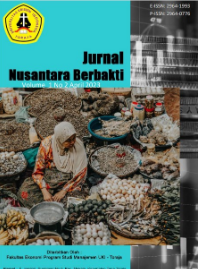Edukasi Karakteristik dan Penggunaan Antibiotik untuk Pengobatan Keluarga
DOI:
https://doi.org/10.59024/jnb.v2i1.309Keywords:
antibiotic, education, knowledgeAbstract
The low level of knowledge about the appropriate use of antibiotics causes the practice of irrational antibiotic use to increase. The aim of this community service is to provide education about understanding antibiotics and how to use them appropriately and rationally. The community service method is by providing education through group discussions, workshops and seminars to health workers, posyandu cadre mothers and the community around Ratujaya Village, Depok. The level of knowledge about antibiotic use was measured using a questionnaire, pretest and posttest. The results achieved by this community service after providing education on understanding antibiotics and their use to the community show that people who have good and sufficient knowledge about antibiotics are 88.57%, meaning that more people understand about antibiotics than those who don't. It can be concluded that the education on the use of antibiotics provided to the public can sufficiently increase public knowledge regarding antibiotics.
References
Afwatunnati, Sunarko dan Setyaningsih, W. (2016). Pengaruh Pengetahuan terhadap Sikap Ibu Rumah Tangga dalam Upaya Mengatasi Pencemaran Lingkungan Akibat Sampah di TPA Jatibarang. Edu Geography, 4(1):24-32.
Fernandez, B.A.M. (2013). Studi Penggunaan Antibiotik Tanpa Resep di Kabupaten Manggarai dan Manggarai Barat-NTT. Calyptra: Jurnal Ilmiah Mahasiswa Universitas Surabaya, 2(2):1-17.
Ihsan, S., Kartina, dan Akib, N.I. (2016). Studi Penggunaan Antibiotik Non Resep di Apotek Komunitas Kota Kendari. Media Farmasi, 13(2):272-284.
Kemenkes. (2011b). Modul Penggunaan Obat Rasional. Jakarta: Direktorat Jendral Bina Kefarmasian dan Alat Kesehatan.
Kementerian Kesehatan Republik Indonesia. (2013). Riset Kesehatan Dasar (Riskesdas). Jakarta: Kementerian Kesehatan Republik Indonesia, p. vivii.
Lubada, E.I., Zulfa, I.M., dan Putri, O.E. (2021). Kaitan Pengetahuan dan Respon Pengunjung Apotek terhadap Penolakan Pelayanan Pengobatan Mandiri Antibiotik. Journal of Pharmacy and Science, 16(1):13-18.
Pavyde, E., Veikutis, V., Maciuliene, A., Maciulis, V., Petrikonis, K., dan Stankevicius, E. (2015). Public Knowledge, Belief and Behavior on Antibiotic Use and Self-Medication in Lithuania. International Journal of Environmental Research and Public Health, 12(6):7002-7016.
Riberu, V. (2018). Tingkat Pengetahuan Masyarakat Tentang Penggunaan Antibiotik Di Desa Weoe Kecamatan Wewiku Kabupaten Malaka. Karya Tulis Ilmiah. Poltekes Kemenkes Kupang.
Richards, J. (2010). Principles of Antibiotic Policies: IFIC Basic Concept and Practice. Edisi 2. Ireland: International Federation of Insection Control.
Shehadeh, M.B., Suaifan, G.A.R.Y., dan Hammad, E.A. (2015). Active Educational Intervention as a tool to improve safe and appropriate use of antibiotik. Saudi Pharm Journal, 24(5):611- 615.
Downloads
Published
How to Cite
Issue
Section
License
Copyright (c) 2023 Rina Hidayati Pratiwi, Endang Sulistyaniningsih, Jumadi Jepri, Theressia Evy Nadeak, Laksita Nirmala Putri

This work is licensed under a Creative Commons Attribution-NonCommercial-ShareAlike 4.0 International License.








